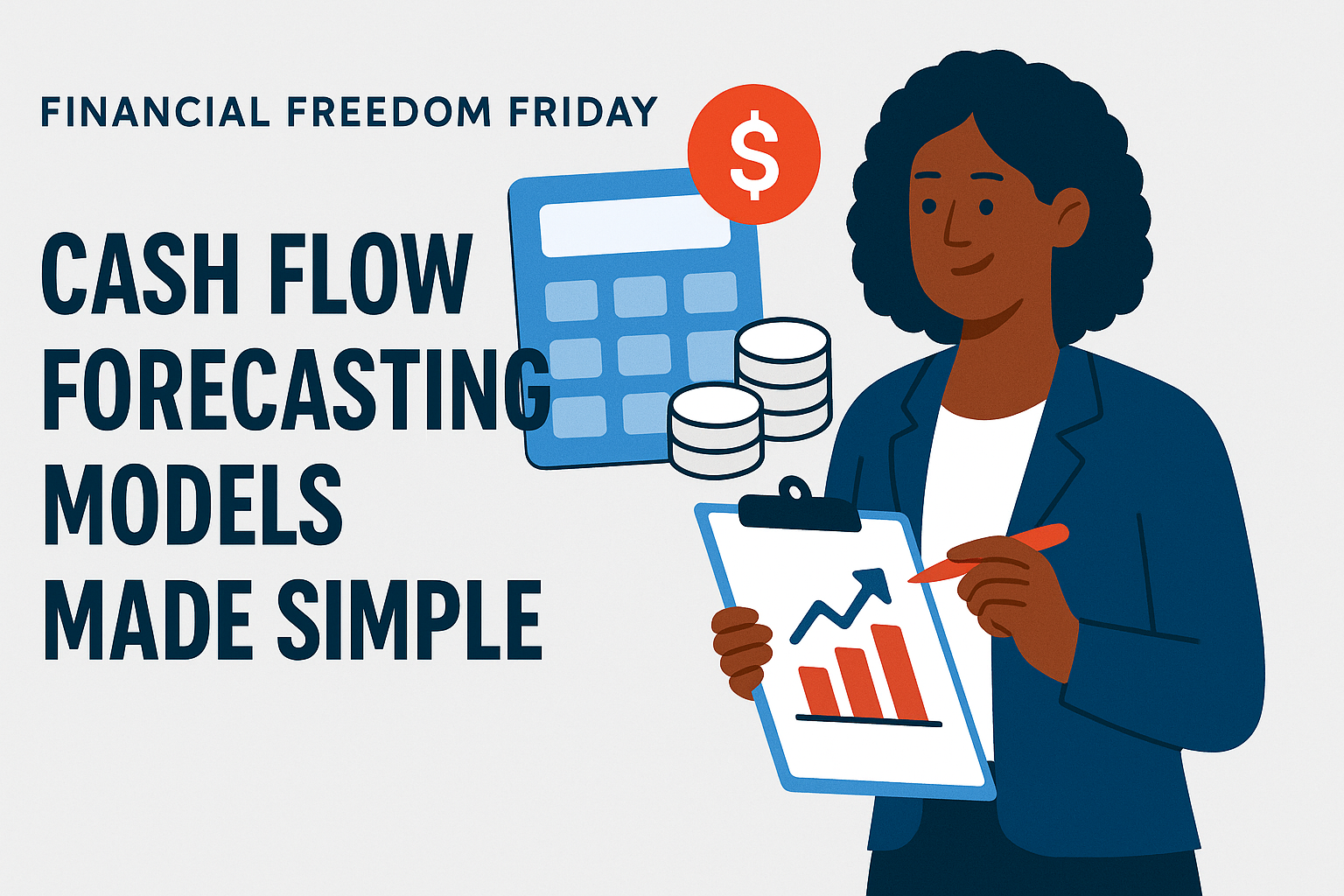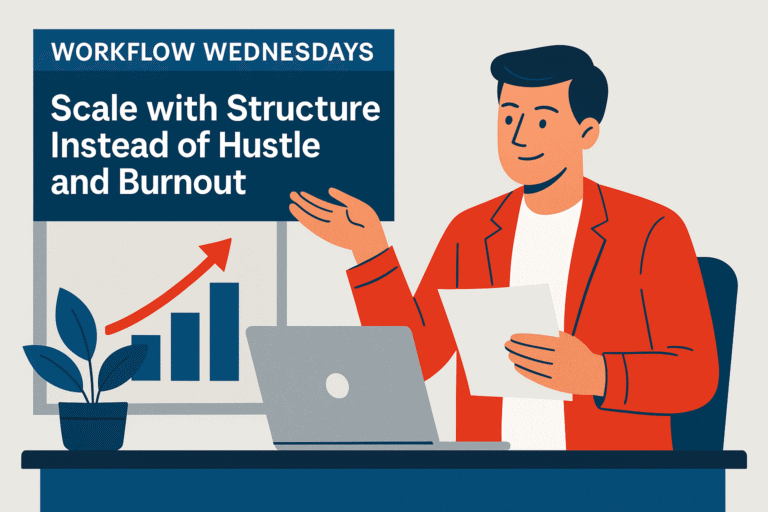Financial Freedom Friday
When I originally started Backbone America back in 2016, it wasn’t a bold leap—it was survival. I had just been laid off from my role as a business advisor. A few of my former clients had actually encouraged me to go out on my own before that happened, but I hadn’t taken the idea seriously. I liked structure. I liked security. But suddenly, I didn’t have either.
So I decided to give entrepreneurship a real shot—not because I had savings or a plan, but because I didn’t have a paycheck.
The truth? Starting a business without money is hard. Starting one without money and without systems… even harder. I knew how to register an LLC and set up QuickBooks, but I still found myself barely treading water a few months in. What kept me afloat back then wasn’t funding. It was a skill I’d picked up while advising others: cash flow management. I knew how to stretch limited dollars, how to plan when there wasn’t much to plan with, and how to prioritize spending with strategy.
Fix Your Cash Blind Spots—Not Just Your Budget (Strategy 1)
When founders talk about managing money, the first thing that comes up is usually budgeting. But budgets are just snapshots. They tell you what you hope will happen—not what’s actually going on. The real issue I see over and over again isn’t bad budgeting—it’s invisible cash decisions.
I’ve worked with entrepreneurs who thought they had a cash problem, but what they really had was a clarity problem. Money was slipping through the cracks because of things like:
Expenses being miscategorized or missed altogether
Revenue projections that were more optimism than data
No reconciliation between bank accounts and bookkeeping
Important decisions being made based on “what feels okay”

When I was rebuilding Backbone America, I didn’t have much to work with financially. But I had full visibility into what was coming in, what was going out, and what absolutely had to be covered. That gave me options. It gave me time. And when things were tight, I could adjust quickly because I wasn’t making guesses—I was making decisions.
If you’re not already doing this, I suggest running a monthly “cash clarity check”:
Pull your bank statements and compare them to your bookkeeping tool or spreadsheet.
List out your recurring expenses (subscriptions, software, tools, etc.) and cancel anything not tied directly to income, growth, or peace of mind.
Label every transaction—not just “marketing” or “admin,” but what it actually supported. Was it a sales tool? A scheduling system? A “just in case” impulse?
Review income trends from the past 3–6 months. Are they flat, rising, or inconsistent?
This isn’t about creating a perfect system. It’s about seeing clearly—so you can stop reacting and start leading.
One thing that helped me early on was building a simplified cash tracker in Google Sheets. Later I moved to Zoho Books, which saved time by automating a lot of the categorization. But the tool doesn’t matter as much as the habit: make the money visible, and you’ll start to manage it differently.
Address Gross Margin Leaks Early (Strategy 2)
Cash flow isn’t just about what you earn—it’s about what you keep from what you earn. That’s where gross margin comes in. And it’s one of the most overlooked metrics in the early stages of business.
Most of us start with pricing based on comparison or emotion. We look at what others are charging, maybe knock a little off because we’re new, and then hope the math works out. But if your pricing only covers your labor or delivery cost, there’s nothing left to sustain the business. You’ll always feel like you’re chasing dollars, even when you’re selling consistently.
For digital products and services especially, the leaks show up in subtle ways:
Saying yes to every customization or extra round of edits
Over-delivering far beyond what was scoped
Using expensive tools or contractors to fulfill lower-priced offers
Absorbing processing fees or platform cuts without raising prices accordingly
I made this mistake in the early days of Backbone America. I priced my courses for affordability—not sustainability. The intention was good, but I ended up building things that were profitable on paper but draining in real life. Once I started calculating how much of each sale was actually supporting my business long-term—not just covering costs—I saw how much I’d been leaking.
So here’s what I recommend:
Calculate your gross margin (Revenue – Direct Costs) ÷ Revenue
Track COGS even if you don’t sell products. For service-based businesses, your time, contractor fees, and delivery tools are all part of that cost.
Audit your offers: Are you creating work that’s labor-heavy with low return? Do your payment plans account for processing fees and delayed cash?
Don’t be afraid to raise prices—or restructure. One small change I made was bundling common services into fixed-scope packages. It reduced revisions, improved delivery time, and increased my effective hourly margin without charging more.
When you plug gross margin leaks early, you don’t just make more—you stabilize your business so the cash you bring in actually builds something.
Manage Inventory and Offers Like a Cash Asset (Strategy 3)

Too much inventory? You’ve overbuilt courses or created too many offers that don’t sell consistently. Too little? You don’t have anything ready to deliver when someone’s ready to buy. Either way, the cash impact is real.
When I first started offering digital products, I had three different programs half-finished and another one completely built but never launched. That’s time and tools I invested—money I spent—that sat idle. Meanwhile, I was paying monthly for platforms I “planned to use” but hadn’t touched in weeks.
Here’s how I reframed it:
If it costs you money and isn’t helping you sell, serve, or save time, it’s not an asset—it’s overhead.
If it lives in your brain or Google Drive and hasn’t been packaged, it’s not inventory—it’s untapped potential.
Managing your offers like inventory means regularly asking:
What am I actively selling—and how is it performing?
Are my delivery tools (LMS, email platform, CRM) optimized or redundant?
What offers can be retired, repackaged, or automated to increase their value?
Am I spread too thin across too many “maybes” instead of doubling down on what works?
One shift that helped me was running a quarterly “offer audit.” I looked at every freebie, low-ticket product, and service I had on the table. If it wasn’t connected to a bigger plan—or wasn’t generating real results—I either paused it or packaged it differently. That cleared mental clutter and freed up resources to reinvest where the return was strongest.
Your digital and mental inventory is a cash asset. Treat it like one, and you’ll be surprised how much more stable your business starts to feel.
Tighten Accounts Receivable + Payables Loops (Strategy 4)
Most new business owners don’t think they have a cash flow issue—they think they have a revenue problem. But often, the issue isn’t how much is being earned. It’s how long it takes to collect, and how fast the money disappears after it lands.
That timing gap? That’s where cash flow gets squeezed.
When I started selling digital products and services, I assumed things would be simple. But I learned quickly: even small delays in payments—or paying vendors too fast out of habit—could throw off my rhythm for weeks. It wasn’t that the money wasn’t coming. It was that the timing didn’t match my needs.
Here’s how that shows up:
Clients who take weeks to pay invoices (or forget entirely)
No follow-up system for outstanding payments
Paying all vendors or tools immediately—even when net terms or grace periods exist
Getting excited about a big sale, then realizing the funds are tied up in platform holds, fees, or long payout cycles
If your business depends on consistent income, you can’t afford to leave this to chance.
What worked for me:
I set clear payment terms from day one—even with friends or referrals. No delivery without deposit.
I automated reminders through Zoho CRM and used milestone-based billing for larger projects.
I requested net 15 or 30 terms from platforms and partners when possible, especially on higher-cost subscriptions.
I monitored platform payout cycles (like Stripe, PayPal, and course marketplaces) so I could forecast what was really available.
You don’t need to become a bill collector. You need to set up systems that support healthy flow.
This is especially critical if you’re juggling a full-time job while growing your business. Late payments or scattered billing can turn what should be a smooth month into a stressful one. Tightening your receivables and payables loops creates breathing room—without requiring more sales.
Profit Isn’t a Mystery—It’s a Math Problem (Strategy 5)

That mindset will keep you stuck.
Here’s what changed for me: I stopped hoping for leftover income and started defining profit as a non-negotiable outcome. That doesn’t mean setting wild income goals or cutting every cost to the bone. It means understanding what profit really is—and making sure the business is designed to generate it.
Profit is just what’s left when the business pays its bills and pays you. If nothing’s left? That’s a business model problem—not a hustle problem.
When I came back to Backbone America after my full-time job in government, I had a clearer goal: to build a lean, profitable system from the start. Not flashy revenue. Sustainable profit. And to get there, I reverse-engineered it:
I defined how much I wanted to earn personally
I mapped out my baseline operating costs (tools, support, delivery)
I added a buffer for taxes, growth, and flexibility
Then I worked backwards to calculate what I needed to charge and how many sales it would take
That gave me clarity. More importantly, it gave me control.
Here’s how you can do this:
Decide your profit target. Even 10–15% is a great starting point.
Add your monthly expenses + your ideal pay.
Factor in taxes and any debt you’re repaying.
Now reverse it. What would your pricing, product mix, and sales targets need to look like to make that possible?
When you see profit as a decision, not a result, you stop waiting for good months to “finally catch up.” You build a business that pays you and supports itself—intentionally.
Bonus Insight: Most Cash Problems Are System Problems

I’ve seen it happen with solopreneurs and small teams alike. They cut expenses, raise prices, push for more sales… but the cash still feels tight. Why? Because the underlying system isn’t designed to support consistent, sustainable growth.
Sometimes the issue is delivery. Too much customization. Too many steps.
Sometimes it’s marketing. Paying for tools you don’t use, or running campaigns that don’t convert.
Sometimes it’s mindset. Thinking profit will come “once you grow,” without realizing growth just amplifies what’s already broken.
When I finally stepped back and looked at Backbone America as a system—not just a passion project—I saw where my own money was getting stuck. I didn’t need a finance degree. I needed to stop operating on memory and hope, and start building a structure that made good money management inevitable.
So here’s the takeaway:
If you keep running into cash stress, don’t just ask, “Where can I cut?”
Ask, “Where is the system leaking?”
Because if the business is built to operate smoothly—without constant patching—profit becomes the default, not the exception.
Conclusion: Sustainable Cash Flow Starts with Intentional Design
Cash flow isn’t about spreadsheets and guesswork. It’s about clarity, design, and discipline—especially when you’re still building. The systems you set up now don’t just help you avoid financial emergencies. They shape how stable, calm, and profitable your business feels to run.
When I restarted Backbone America, I didn’t have a cushion. What I had was a plan for how to stretch every dollar, how to pay myself without starving the business, and how to keep cash flowing even when sales were inconsistent. That plan didn’t come from hustle. It came from strategy.
If you’re in a season where every dollar counts, here’s where to start:
1. Pick one day each month to run your numbers—just 30 minutes to review income, expenses, and cash available. Put it on your calendar.
2. Identify one leak in your cash flow—an underpriced offer, an unused tool, a late invoice—and fix it this week.
3. Define a simple profit goal for the next 90 days (even if it’s just $200/month), then reverse-engineer how you’ll reach it with what you already have.
Small moves add up when they’re consistent.
Because financial freedom doesn’t come from luck. It comes from systems—and from you deciding to treat your business like it’s built to last.






